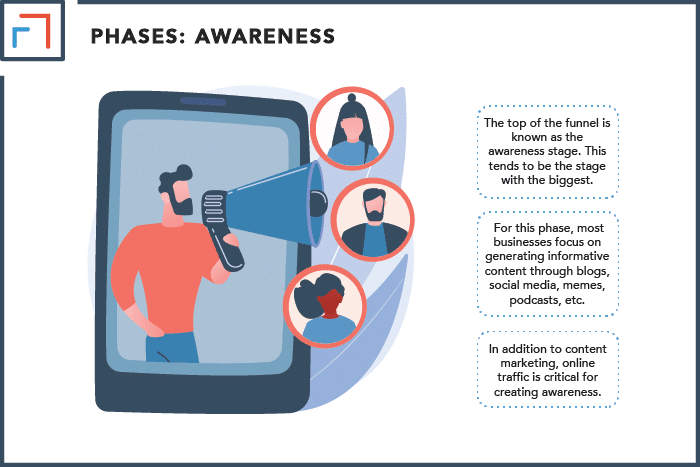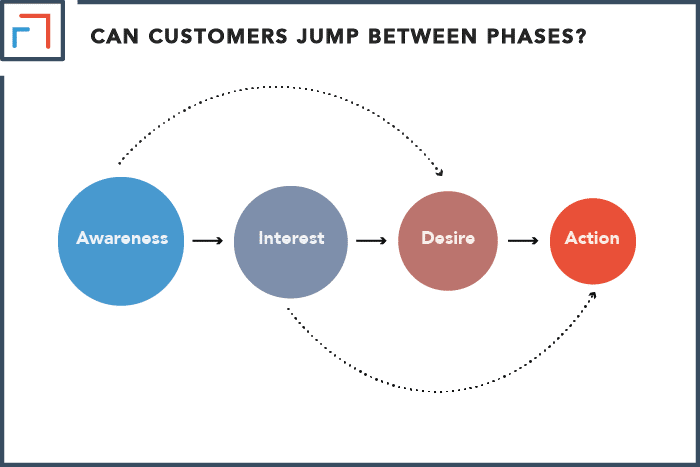Marketing strategies are constantly adapting so they can better fit the evolving behaviors of customers. Funnel marketing helps businesses develop strategies that are relevant to their customers’ position in the brand journey. There are four major stages that form funnel marketing strategies.
The four major components of funnel marketing are Awareness, Interest, Desire, and Action. Sometimes these phases happen in order and sometimes customers jump around to different phases. These stages develop a relationship with the customer and encourage them to make a commitment.
The funnel marketing phases apply to any business. They are so effective that they have been adopted by several brands to help them establish distinct identities and build strong customer relationships. This article will explore the different stages and their applications in the real world.
Phases of Funnel Marketing
Funnel marketing is centered around a customer journey map. Marketing strategies are put in place based on where the customer is during their brand journey.
Once you understand how much people already know about your brand, you can build strategies from that point.
1. Awareness
The top of the funnel is known as the awareness stage.
This tends to be the stage with the biggest audience because it’s easier to tell people that your brand exists rather than convince them to buy something.
As a result, companies have the opportunity to inform a massive audience about their service and brand identity.
For this phase, most businesses focus on generating informative content through blogs, social media, memes, podcasts, etc.
Watching your metrics for this phase is important because they help you evaluate whether your content marketing strategies are effective in increasing brand awareness.
For example, social media impressions, follow-ups, and engagement can be analyzed.
Once you know your strengths and weaknesses, you can tweak your content accordingly.
At the awareness stage, it is crucial to generate content that will attract the right audience.
You can do this by applying research-backed demographic profiling of your desired audience.
This ensures that your content addresses the interests and needs of a specific group. In addition to content marketing, online traffic is critical for creating awareness.
Using Facebook ads, SEO optimization, and an active social media presence are common strategies for directing traffic to your company’s website and landing pages.

2. Interest
Once your potential customers know that your company exists, you need to nurture their feelings by generating interest in whatever you have to offer.
Your company’s product/service needs to be related to the problems of the target audience. If they don’t need your product, they won’t buy it!
Once you learn about the consumer’s issues, you can use specific strategies to create engagement.
This can be done through promotional videos, influencer support, and brand ambassador advocacy.
At this point, you are developing a valuable, direct relationship with your consumers.
To spark customer interest in your company, you need to showcase a unique element that speaks to the audience.
For instance, if you have a bakery business that offers baked goods with natural sweeteners, you could develop a niche by promoting this particular aspect of your brand identity.
Look for the thing that sets your business apart from the competition. If you can create interest, people are more likely to remember you and buy your product/service.
3. Desire
We’re all aware of the mouthwatering visuals that fast food businesses use for their billboards. This strategy effectively creates a desire for the displayed food.
This is a single example of how brands try to convince their target consumers to indulge in their service or product.
This is a decisive phase of funnel marketing, so desire is essential for customers to jump from interest to purchase.
Therefore, you should make sure that you provide helpful information that will answer questions and concerns your customers might have.
You can also consider offering discounts, coupons, and free trials for your product(s). If you offer a good deal, the desire to buy grows stronger.
A prominent content marketing strategy is to send free products to bloggers and journalists.
In exchange, they could publish comparative videos and analyses of your company’s product with competitors in the market.
Doing this would inform your consumer base about your products and help you gain a good reputation from outside sources.

4. Action
This is the stage that your entire funnel strategy has been working towards.
For most businesses, the action stage is all about getting customers to buy something from you.
In other cases, the action might be something like watching a webinar or subscribing to your email newsletters.
Make sure to include a direct call to action so you can push the customers to make a purchase/commitment.
This CTA should be placed strategically on your landing pages and informational pages, so there’s always a clear path forward.
Providing incentives for purchase can make this process smoother. This could be in the form of promotional offers or even first purchase coupons.
Upsells are commonly used since they help convince customers to make last-minute purchases.
Moreover, you need to ensure that purchasing your service or product is quick and hassle-free.
If you have a smooth payment process with multiple options, like credit/debit card, PayPal, Apple Pay, etc., this helps you seem more credible and professional.
Another advantage is the increased probability of referrals since the customer would have completed their brand experience without any frustrations.
Finally, keep the checkout process simple and direct the customer to a thank you page once they’re done.
Can Customers Jump Between Phases?
Although we often talk about funnel marketing phases in a linear way, it is very common for a potential customer to go from awareness to desire directly, or from interest to action.
This is because social media and the internet have created a very nonlinear form of digital marketing. Customers are more easily connected with one another nowadays.
This means that a customer can pass the awareness stage of funnel marketing and decide to make a purchase by simply watching a TikTok review of the brand or product.
This can be both good and bad for a brand since you could lose or gain a customer from external critique before you get the chance to connect with them directly.
Entrepreneurs need to adapt to the shifting market environment and map out their customer journeys.
This will help them design effective funnel marketing strategies.
Since customers can skip stages during their brand journey, it is critical for the brand to have a customized approach backed up by research and audience profiles.

Summary
Funnel marketing is an important part of running a business.
It involves developing the right kind of content for your audience and finding the best strategies to deliver it.
By closely following the four stages of Awareness, Interest, Desire, and Action, brands can ensure that different types of customers are being reached.
As a result, you can better understand your customers and form a direct connection with them by using relevant marketing.
In the end, all four stages work towards developing your business as a brand.
Customers may jump around the phases, but it’s important to develop each one properly.
